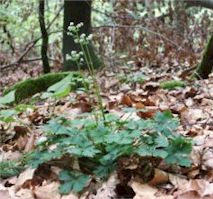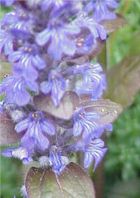|

Sanicle |
Several Herbal Simples go by the name of Selfheal among our wild hedge plants, more especially the Sanicle, the common Prunella, and the Bugle.
The first of these is an umbelliferous herb, growing frequently in woods, having dull white flowers, in panicled heads, which are succeeded by roundish seeds covered with hooked prickles: the Wood Sanicle (Europoea).
It gets its name Sanicle, perhaps, from the Latin verb sanare, "to heal, or make sound;" or, possibly, as a corruption of St. Nicholas, called in |
German St. Nickel, who, in the "Tale of a Tub", is said to have interceded with God in favour of two children whom an innkeeper had murdered and pickled in a pork tub; and he obtained their restoration to life.
Anyhow, the name Sanicle was supposed in the middle ages to mean "curative," whatever its origin: thus, Qui a la Bugle, et la Sanicle fait aux chirurgiens la nicle "He who uses Sanicle and Bugle need have no dealings with the doctor." Lyte and other herbalists say concerning the Sanicle: "It makes whole and sound all wounds and hurts, both inward and outward."
"Celui qui Sanicle a De plaie affaire il n'a."
"Who the Sanicle hath At the surgeon may laugh."
The name Prunella (which belongs more rightly to another herb) has been given to the Sanicle, perhaps, through its having been originally known as Brunella, Brownwort, both because of the brown color of its spikes, and from its being supposed to cure the disease called in Germany die braune, a kind of quinsy; on the doctrine of signatures, because the corolla resembles a throat with swollen glands.
The Sanicle is popularly employed in Germany and France as a remedy for profuse bleeding from the lungs, bowels, womb, and urinary organs; also for the staying of dysenteric diarrhea. The fresh juice of the herb may be given in tablespoonful doses.
As yet no analysis has been made of this plant; but evidence of tannin in its several parts is afforded by the effects produced when these are remedially applied.
The Prunella vulgaris is a distinct plant from the Self Heal, or Sanicle, and belongs to the labiate order of herbs. It grows commonly in waste places about England, and bears pink flowers, being sometimes called Slough heal. This is incorrect, as the surgical term "slough" was not used until long after the Prunella and the Sanicle became named Self-heal. Each of these was applied as a vulnerary, not to sloughing sores, but to fresh cut wounds.
The "Prunella Vulgaris" has a flattened calyx, and whorls of purplish blue flowers, which are collected in a head. It is also known as Carpenter's Herb, perhaps, from its corolla, when seen in profile, being shaped like a bill hook; and therefore, on the doctrine of signatures, it was supposed to heal wounds inflicted by edge tools; whence it was likewise termed Hook-heal and Sicklewort, arid in Yorkshire, Black man.
By virtue of its properties as a vulnerary it has also been called Consolida; but the daisy is the true Consolida minor.
"The decoction of Prunell," says Gerard, "made with wine and water, doth join together and make whole and sound all wounds, both inward and outward, even as Bugle doth. To be short, it serveth for the same that the Bugle serveth; and in the world there are not two better wound herbs, as bath been often proved."
|

Bugle |
The Bugle, or middle Comfrey, is also a Sanicle, because of its excellence for healing wounds, in common with the Prunella and the true Sanicle. It grows in almost every wood, and copse, and moist shadowy place, being constantly reckoned among the Consounds.
This herb (Ajuga reptans) is of the labiate order, bearing dark blue or purple flowers, whorled, and crowded into a spike. Its decoction, "when drunk, healeth and maketh sound all wounds of the body." "It is so singular good for all sorts of hurts that none who know its usefulness will be ever without it. If the virtues of it make you fall in love with it (as they will if you be wise), keep a syrup of it, to take inwardly,
and an ointment and plaister of it to use outwardly, always by you." |
The chemical principles of the Prunella and the Bugle resemble those of other Labiate herbs, comprising a volatile oil, some bitter principle, tannin, sugar, and cellulose. The Ladies' Mantle, Alchemilla--a common inconspicuous weed, found everywhere--is called Great Sanicle, also Parsley-breakstone, or Piercestone, because supposed to be of great use against stone in the bladder. It contains tannin abundantly, and is said to promote quiet sleep if placed under the pillow at
night. "Endymionis somnum dormire."
Herb Simples
The Primitive Simplers presented here show the way of life in other generations, it is not suggested or recommended trying them yourself. |
|
Garden
Herbs
Home
History of Herbs
Herb Gardening
Herbs for Beginners
Drying & Preserving Herbs
Indoor Herb Gardening
Herb Garden
Hints & Tips
Herbal
Cooking
Herb Chart
Using Herbs
Culinary Herbs
Herb
Oil and Vinegar
Herb Teas
Herb Candy
Herb Jelly
Herb Simples
Preface
Introduction
Alphabetical Listing

Trade
Recipes Online
Share your Recipes with others!!
|



